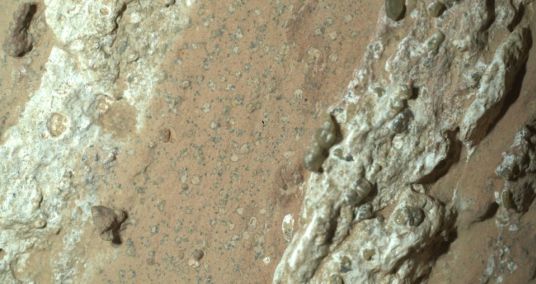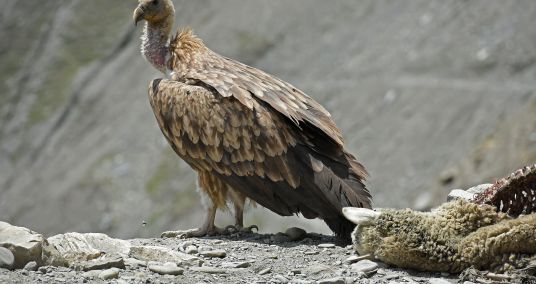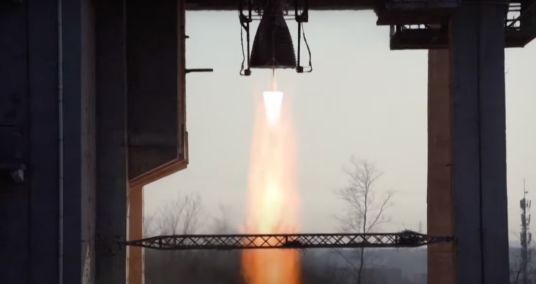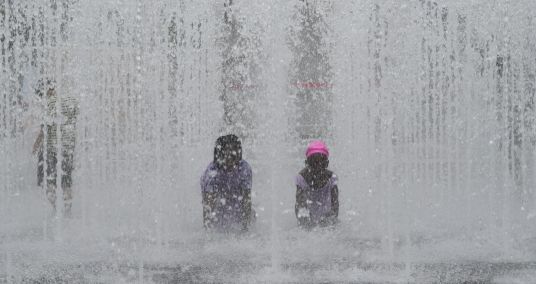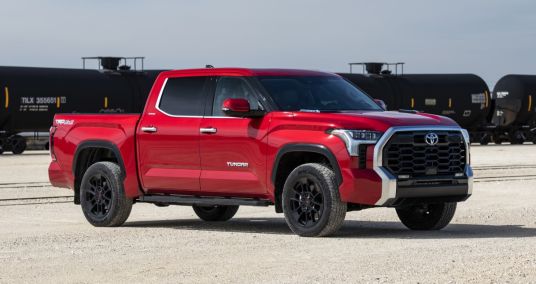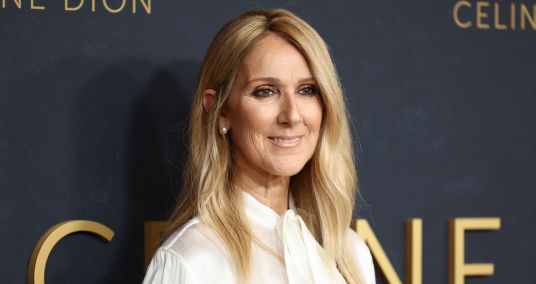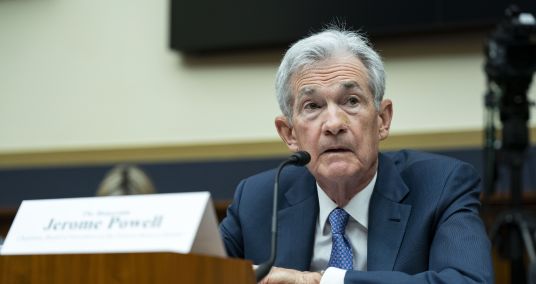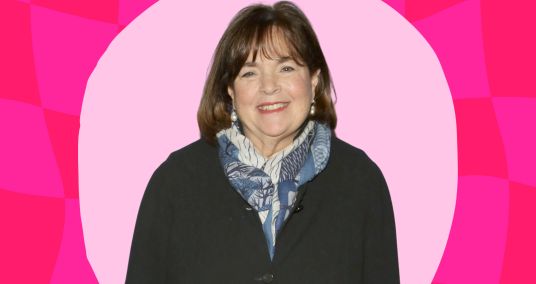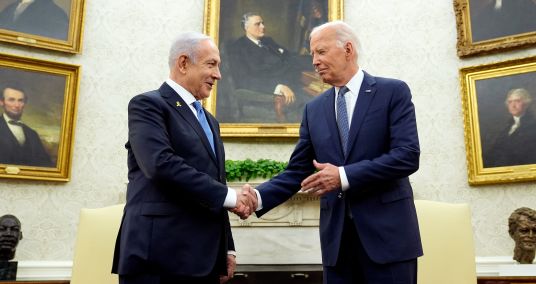Science
- USNBC News
Smoke from wildfires in Canada and the West Coast spreads across North America
Intense wildfires in western Canada have sent plumes of smoke across North America, and fires in Oregon, Idaho and California are also causing air quality to drop.
3 min read - ScienceCNN
Perseverance rover finds evidence that suggests ancient microbial life might have existed on Mars
The Perseverance rover has found evidence in a leopard-spotted rock that could suggest microbial life once existed on Mars billions of years ago, NASA said.
6 min read - USAssociated Press
US coastal communities get $575M to guard against floods, other climate disasters
The federal government is giving more than a half-billion dollars to coastal communities to help them use nature-based preventative measures to address climate-related flooding and other disasters. The National Oceanic and Atmospheric Administration on Friday announced it is allocating $575 million to 19 resiliency projects in several states, with a particular emphasis on Native American, urban and traditionally underserved communities that experience repeated floods, wildfires and other weathe
2 min read - BusinessCNN
SpaceX cleared to launch Falcon 9 rocket after rare failure
The FAA has cleared SpaceX’s Falcon 9 to fly once again after an explosive mishap left it grounded for two weeks.
5 min read - USReuters
Oregon wildfire explodes to half the size of Rhode Island
(Reuters) -Winds and lightning strikes have sparked and fanned wildfires across the Pacific Northwest this week, including the largest fire in the United States, which was rapidly expanding near the Oregon-Idaho border on Friday. The Durkee Fire near Huntington, Oregon, about 100 miles (160 km) north of Boise, Idaho, has scorched 600 square miles (1,553 square km), an area more than half the size of Rhode Island's land mass, authorities said. While there is zero chance of rain through next wee
3 min read - WorldCBS News
India lost its vultures, and scientists say humans have paid the price
Scientists say a common painkiller used on cattle wiped out India's vultures, resulting in half a million human deaths in just 5 years.
5 min read - ScienceSpace
How spaceflight’s 'parastronaut program' could improve health-care practices here on Earth
ESA reserve astronaut John McFall's story inspired a study suggesting that the space community's inclusion efforts should be used in other fields, especially medicine.
6 min read - ScienceSpace
These 2 US cities are the most vulnerable to solar storms, scientists say
Geomagnetic storm-induced blackouts may be looming.
2 min read - ScienceSpace
Satellites are game changers for protecting coral reefs in a warming world
Over the years, satellites have played an important role in monitoring oceans and coral reefs all across the globe.
6 min read - ScienceSpace
How stars' magnetic fields could impact the chance for life on orbiting planets
Habitability depends on more than just a planet's distance from its host star. New research looks at the impact stellar magnetism has on exoplanets.
5 min read - BusinessSpace
SpaceX finds cause of Falcon 9 failure, eyes return to flight as soon as July 27
SpaceX has fixed the problem that caused its Falcon 9 rocket to fail during a July 11 launch, according to the company, which is eyeing a July 27 return to flight.
3 min read - HealthNBC News
Research on bird flu in cows shows how efficiently it has spread among mammals
Research into the bird flu outbreaks on dairy farms describes how efficiently the virus has spread between cows and from cows to other mammals, including cats and a raccoon.
4 min read - ScienceSpace
NASA's Perseverance Mars rover finds possible signs of ancient Red Planet life
NASA's Perseverance rover stumbled upon a Mars rock. It seems to suggest evidence of ancient life on the Red Planet.
4 min read - WorldAssociated Press
Citing climate change, a federal court in Brazil halts rainforest highway paving
In an unusual action, a Brazilian federal court halted progress on a project to pave a dirt highway that connects the major city of Manaus to populous regions, ruling it likely will contribute to climate change. The court suspended on Wednesday a key environmental permit after the Climate Observatory — a network of 107 environmental, civil society and academic groups — argued that the preliminary permit could lead to mass clearing of pristine rainforest. Amazon deforestation is the major sourc
2 min read - ScienceCBS News
Boeing's Starliner space capsule faces crucial tests
NASA and Boeing managers are increasingly confident the Starliner capsule is good to go for re-entry and landing.
4 min read - ScienceSpace
X-rays reveal secret gas in huge and distant galaxy cluster
The Euclid and XMM-Newton missions have combined to show the hidden, hot gas that fills an immense galaxy cluster 2.7 billion light-years away.
6 min read - ScienceCNN
Boeing, NASA may have found ‘root cause’ of Starliner spacecraft’s issues, but astronauts are still in limbo
After weeks of testing, NASA and Boeing officials say they better understand the issues plaguing the Starliner spacecraft, but still aren’t ready to name a return date.
5 min read - ScienceSpace
Boeing Starliner 1st astronaut flight: Live updates
Boeing moving toward a June 1 launch of its first-ever Starliner astronaut mission for NASA.
49 min read - ScienceSpace
Runaway 'failed star' races through the cosmos at 1.2 million mph
Citizen scientists have discovered what may be a brown dwarf racing through the cosmos at around 1.2 million miles per hour. Now astronomers want to know what launched it.
7 min read - ScienceSpace
50 days after launch to ISS, Boeing Starliner astronauts still have no landing date
Boeing's Starliner does not have a landing date yet, but the troubleshooting is making progress. Engineers plan a "hot fire" test this weekend to see how the spacecraft does in orbit.
8 min read - ScienceSpace
Next Blue Origin space tourism flight will launch youngest woman above the Kármán line
Blue Origin has announced the six crewmembers for its next space tourism flight. One of them will become the youngest woman to cross the Kármán line.
2 min read - ScienceSpace
Watch China test-fire engine for new crewed moon rocket (video)
China has test-fired a new engine for its planned Long March 10 rocket, which is designed to take astronauts to the moon.
2 min read - ScienceAssociated Press
NASA says no return date yet for astronauts and troubled Boeing capsule at space station
Already more than a month late getting back, two NASA astronauts will remain at the International Space Station until engineers finish working on problems plaguing their Boeing capsule, officials said Thursday. Test pilots Butch Wilmore and Suni Williams were supposed to visit the orbiting lab for about a week and return in mid-June, but thruster failures and helium leaks on Boeing's new Starliner capsule prompted NASA and Boeing to keep them up longer. NASA’s commercial crew program manager S
2 min read - ScienceSpace
Space is becoming an 'unsustainable environment in the long term,' ESA says
Large amounts of space debris and satellite megaconstellations in low Earth orbit are creating "an unsustainable environment in the long-term," according to a new report from the European Space Agency.
4 min read - ScienceCNN
Hens blush when excited or scared, study finds
Blushing was once thought to be the “most peculiar and most human of all expressions,” as Charles Darwin put it, but a new study has found that hens share this peculiarity and can also express their fear or excitement in this way.
3 min read - USCBS News
Italian archaeologists make stunning underwater discovery
The discovery includes "thousands of marble slabs" in "hundreds of different shapes" found in a submerged ancient city.
2 min read - BusinessSpace
SpaceX rocket failure highlights need for multiple launch options: 'Falcon 9 is not invulnerable'
SpaceX's workhorse Falcon 9 is one of the most reliable and prolific rockets ever flown. But it's not invulnerable, as we saw earlier this month.
3 min read - ScienceSpace
Florida startup Star Catcher snags $12 million to help develop 1st off-Earth energy grid
Star Catcher Industries just snagged $12.25 million to develop its planned constellation of power-beaming satellites, which will service other orbiting spacecraft.
3 min read - ScienceSpace
ISS scientists make headway in cancer research: 'We're NASA, we do Moonshots'
NASA's Cancer Moonshot Initiative aims to harness microgravity conditions on the International Space Station to study the disease like never before.
4 min read - USAssociated Press
UN asks nations to better prepare, cool the vulnerable as 'extreme heat epidemic' breaks records
After three of Earth's hottest days ever measured, the United Nations called for a flurry of efforts to try to reduce the human toll from soaring and searing temperatures, calling it “an extreme heat epidemic.” “If there is one thing that unites our divided world, it's that we're all increasingly feeling the heat,” United Nations Secretary-General Antonio Guterres said Thursday at a news conference where he highlighted that Monday was the hottest day on record, surpassing the mark set just a da
5 min read - WorldAssociated Press
Africa's demand for cooling systems is expanding. But regulating the industry is a struggle
A technician had recently helped him refill the air conditioner with gas, but he didn’t test for possible leaks. The industry is governed by regulations prohibiting the release of cooling gases into the air, for example by conducting leak tests after an appliance is fixed.
6 min read - USAssociated Press
A plan to replenish the Colorado River could mean dry alfalfa fields. And many farmers are for it
A plan to help shore up the depleted Colorado River by cutting off water to alfalfa fields in California's crop-rich Imperial Valley is finding support from the farmers who grow it. The Imperial Irrigation District — the biggest user of water from the 1,450-mile (2,334-kilometer) river — has offered to pay farmers to shut off irrigation to forage crops including alfalfa for up to 60 days during the peak of the sweltering summer. While farmers often balk at the idea of letting fields lie fallow
4 min read - ScienceSpace
NASA, Boeing discuss Starliner astronaut mission today: Watch the replay
NASA and Boeing will provide an update about the Starliner capsule's ongoing astronaut mission today (July 24), and you can watch it live.
2 min read - SportsYahoo Sports
2024 Paris Olympics: How to watch swimming, full events schedule and more
Here's how to watch Team USA make a splash at the Summer Olympics.
5 min read - BusinessAutoblog
Toyota will replace engines in 100,000 recalled Tundras and Lexus LXs
Toyota recalled about 102,000 units of the Tundra and the Lexus LX due to an engine problem. It will replace the engine in affected vehicles.
2 min read - HealthYahoo Canada Style
Céline Dion delivers emotional performance at the Paris 2024 opening ceremony — her first since cancelling tour due to Stiff Person Syndrome: Signs, symptoms & how it affected her voice
The 56-year-old Canadian singer has been experiencing symptoms of SPS for the last 17 years.
4 min read - SportsYahoo Sports
How to watch Team USA Women's Basketball at the 2024 Paris Olympics: Full schedule, where to stream games and more
Here's how to watch every Team USA men's basketball game at the Paris 2024 Olympics.
5 min read - BusinessYahoo Finance
Fed's preferred inflation gauge shows prices rose at slowest pace since March 2021
The latest reading on the Fed Reserve's preferred inflation gauge comes just days before the Fed's next policy meeting as investors look for clues on when interest rate cuts might begin.
2 min read - StyleYahoo Life Shopping
Ina Garten says these 'incredibly comfortable' walking shoes 'changed my life'
The Barefoot Contessa was just spotted wearing the cushy kicks in Paris, and she's even included the sneakers in gift guides.
4 min read - CelebrityYahoo TV UK
Celine Dion keeps fans waiting at Paris Olympics 2024 Opening Ceremony
Viewers were excited and frustrated amid rumours the French-Canadian singer would make her comeback performance during the four hour ceremony.
4 min read - CelebrityYahoo News Canada
Celine Dion fans rejoice as Canadian icon performs on Eiffel Tower to cap Paris Olympics opening ceremony
Friday marked Dion's first live performance since the superstar singer revealed she was living with a rare, progressive disorder known as Stiff Person Syndrome.
4 min read - StyleYahoo Life Shopping
Jennifer Lopez is sporting these timeless summer sandals — get the look for $30
If you need some easy footwear to pair with, well, everything, take a page from J.Lo's book and grab some leather flip-flops.
3 min read - BusinessYahoo Finance
Stock market news today: Dow jumps over 650 points as stock surge caps volatile week on Wall Street
Investors are looking to the Fed-favored inflation data to calibrate the timing and depth of rate cuts.
2 min read - PoliticsYahoo News
Who is leading the race to become Kamala Harris's running mate? New Yahoo News poll shows support for top contenders.
A Yahoo News guide to the top Democratic vice-presidential contenders
9 min read - WorldYahoo News UK
Olympics opening ceremony: Flying cauldron and Celine Dion close spectacular (rain-hit) event
A drenched opening ceremony couldn't dampen the Olympic spirit as the Paris Games officially opened with a stunning Olympic cauldron floating in the sky.
1 min read - SportsYahoo News Canada
Canada floats into Paris Olympics in style as first-of-its-kind opening ceremony kicks off 2024 Games
Team Canada takes to the Seine River with Andre De Grasse and Maude Charron leading the way.
4 min read - BusinessYahoo Finance
2 charts show why the stock market sell-off isn't done yet
The stock market rally has started to wobble in July and market strategists believe this could be the start of the average pullback seen in bull markets.
3 min read - EntertainmentYahoo News Canada
2024 Paris Olympics: Best Opening Ceremony photos, from the Eiffel Tower light show to Céline Dion's performance
From an incredible Eiffel Tower light show to Céline Dion returning to the stage, see some of the best moments from the 2024 Paris Olympics Opening Ceremony.
- NewsThe Yodel
Netanyahu faces pressure on a ceasefire deal, what to expect at the Olympics opening ceremony, Billy Joel ends historic residency
Get caught up on this morning’s news: Olympics opening ceremony, Netanyahu’s U.S. visit continues and more in today’s edition of The Yodel newsletter
4 min read - SportsYahoo Canada Style
Team Canada will be wearing this to the Olympics opening ceremony — shop our picks
Now, let's all wear Lululemon and manifest gold medals across the board for Team Canada.
4 min read

